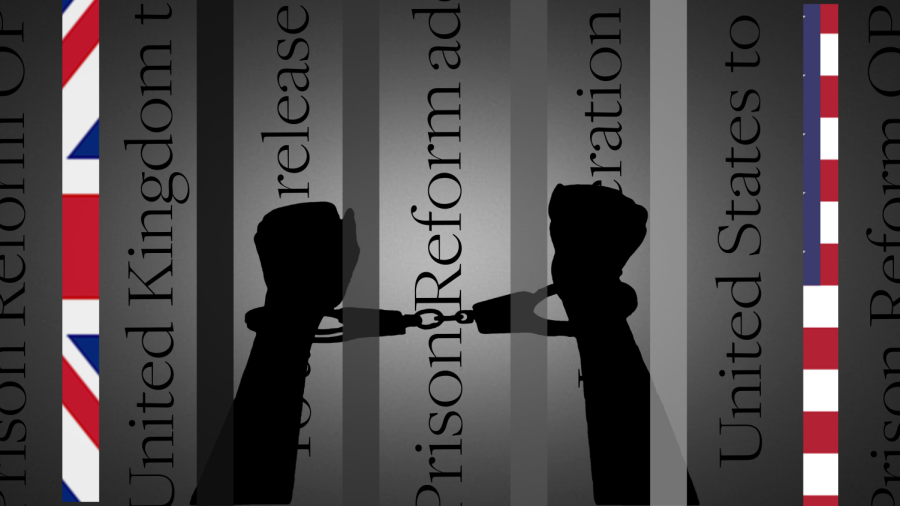Cushman: Supporting Ex Convicts Makes Society Better
(Graphic by Emily Christensen | The Daily Utah Chronicle)
December 9, 2021
The United States has the highest incarceration rate and prison population in the world, with 2.3 million people confined nationwide. As Edgar Montero, a former Utah prisoner, told me, prison punishes prisoners “every day of their sentence.” Most Americans are happy to see that punishment continue after a jail term ends, which may explain why there is a severe lack of resources to help prisoners adjust to the outside world after incarceration. However, leaving ex-cons without support creates higher recidivism rates, something that affects all of us.
Temporary work release has been linked to post-incarceration success in Utah. Countries like the UK have expanded temporary work releases further to help rehabilitate inmates, resulting in lower recidivism and higher employment success for ex-prisoners. Utah and the United States should expand its prison release programs as a first step toward lower recidivism and a more rehabilitative system.
Barriers After Incarceration
Prisoners face many barriers when they leave prison. Employers are reluctant to hire ex-cons — only 12.5% of employers will accept an application from a former prisoner. Housing, too, can be difficult to find as some public housing and housing vouchers are off-limits, parole restrictions can limit where they’re allowed to live and many landlords are wary of renting to former prisoners.
Montero explained that when he transitioned out of prison, Utah policy allowed prisoners to receive $100 of “gate money” to walk away with if they had no money in their account. But if they had even $10 or $20 in their account, the prison would not give them $100. Most states offer gate money sums, ranging from as little as $10 to $200 at the highest end. If an inmate has no family or friends to fall back on, even $200 will not get them very far, setting them up for failure the minute they leave.
Former prisoners also face the barrier of a world that changed while they were behind bars. Another former Utah prisoner, Matthew Holman, told me about how some of his friends left prison and didn’t know how to use Google. We release inmates into an unfamiliar environment with technology they don’t know how to use.
The barriers prisoners face post-incarceration are huge. They don’t have the option to work harder for success because they can’t work, they can’t find housing and they don’t have the skills to navigate the society they are released into. They have no access to the American dream. Our system punishes them even after they’ve paid the debt of their sentence.
The Cost of Those Barriers
With few resources for reintegration and many barriers to employment and housing, prisoners often turn back to crime, contributing to high recidivism. In the U.S., 67.8% of ex-offenders are rearrested within three years and 76.6% within five years. Recidivism can cost states a lot of money. In 2017, each reconviction cost Illinois $151,662. In Utah, 46% of inmates return to jail within three years. Limited statistics on the cost of reconvictions make it hard to know the dollars we spend on recidivism, but we do know that prosecuting and housing prisoners is expensive.
Recidivism also has a moral cost. The United Nations says “the rehabilitation of offenders and their successful social reintegration into society should [therefore] be among the basic objectives of criminal justice systems.” They lay out that guideline for good reason. When our justice system fails to rehabilitate inmates, we reinforce the racial and economic social inequalities that exist. Equal opportunity, a key part of the American dream, is destroyed in the process. Not only that, recidivism reduces public safety. When ex-cons reoffend, it contributes to crime and creates new victims. If we want a justice system that reduces crime, we need to focus our efforts on rehabilitation rather than punishment.
Introducing A Broader Temporary Release Program
Utah county has the largest jail industries program in the nation. Over two decades, it has allowed over 10,000 inmates to hold jobs in the community during their sentence, reducing recidivism in the state by helping inmates maintain employment after prison. However, temporary prison release doesn’t need to end with work releases.
The UK temporarily releases prisoners, especially as they near the end of their sentence, for work, education, to sleep at their post-incarceration residence or to spend time with their child(ren). The program allows inmates to integrate more gradually into their life post-incarceration. Evidence shows that expanded temporary release programs have helped prisoners reintegrate after incarceration, find employment and overall reduce recidivism. When I talked to Holman, he said a program like that in the United States could allow inmates to integrate in a manner that is less daunting. Utah and the United States suffer from high recidivism and all its ill effects. The UK’s rehabilitative temporary prison release program could help remedy that.
The American dream is built on the idea that hard work breeds success. That isn’t true for American prisoners right now. The cost of that stolen American dream doesn’t land just on ex-convicts. It lands on all of us through recidivism costs and lower public safety. If we believe in second chances, if we want to lower the social costs of recidivism and if we care about the American dream, we’ll consider expanded temporary release programs to help prisoners reintegrate after incarceration.










Dudley Sharp • Jan 27, 2022 at 2:51 pm
I agree with you on the major point. “Bridges to Life” and other US programs have done great work lowering recidivism rates and improving the choices for those released.
I disagree on two points.
1) “The cost of that stolen American dream”
That dream was not stolen from them. They threw it away when they decided to harm innocents. You need to hold people responsible for their own actions.
The “stolen” was that from the innocent victims, often forgotten.
2) “If we believe in second chances”
Most often we give 2, 3 or more chances, with probation, often being given, so that they can expunge their records, if probation was well served.
Crime Rates
In 2014, the huge increase in our incarceration rates, with other issues, resulted in 40-60 lows various violent crime rates, with millions of crimes prevented, by the 40 year rise in incarceration rates.
Dudley Sharp • Feb 17, 2022 at 2:45 am
Correction:
, resulted in 40-60 YEAR lows IN various violent crime rates, with millions of crimes prevented, by the 40 year rise in incarceration rates.